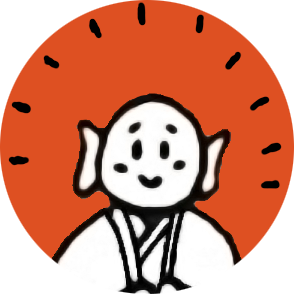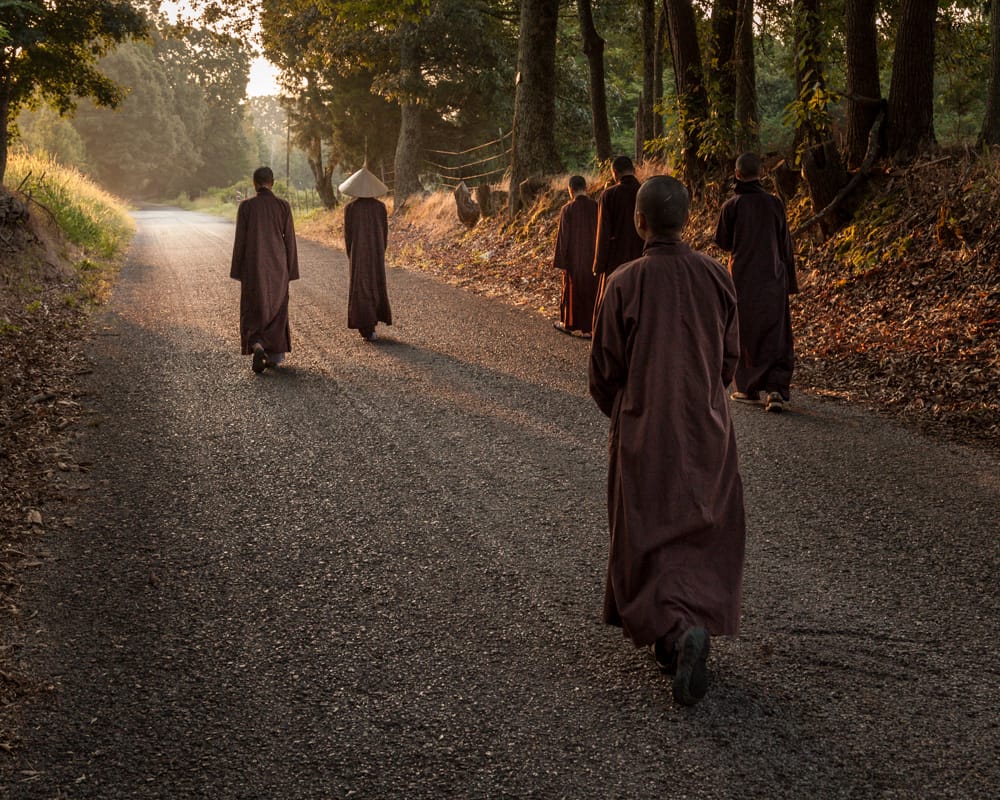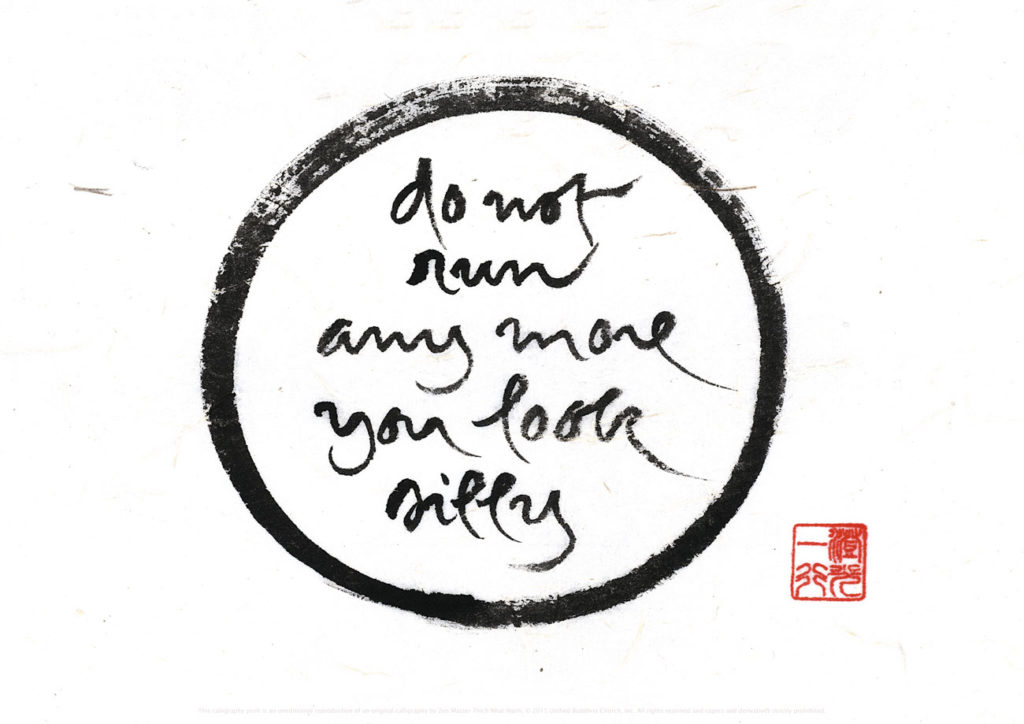Original Vietnamese title: “Ngồi Thiền Làm Lắng Ba Nghiệp [Thực Tập Căn Bản Làng Mai] TS Nhất Hạnh (05-01- 2014)”
Originally posted by: Làng Mai (Plum Village’s Vietnamese YouTube channel), https://youtu.be/BNkGOlzEjFo
Talk given: January 05, 2014, Dharma Cloud Temple (Chùa Pháp Vân), Upper Hamlet, Plum Village France
Length: 8 minutes 48 seconds
Video’s note: Trích pháp thoại ngày 05-01- 2014, Xóm Thượng, Làng Mai, Pháp.
This is an excerpt of the Dharma talk given on January 5, 2014 in Upper Hamlet, Plum Village France.
Transcript
Winter 2013-2014 – THE WELL-TRODDEN PATH OF THE CONSCIOUSNESS
Dharma Cloud Temple (Chùa Pháp Vân), Upper Hamlet – January 05, 2014
So, before sitting in meditation, we have a chant. The Evening Chant goes,
“With posture upright and solid,
we are seated at the foot of the Bodhi tree.
Body, speech, and mind are one in stillness;
There is no more thought of right and wrong.”
“With posture upright and solid, we are seated at the foot of the Bodhi tree” means, I’m sitting here like the Shakyamuni Buddha sitting at the foot of the Bodhi tree. This is a chance. Sit stably and solidly. And the very first thing I should do is to calm the three actions of my body, speech, and mind.
“Body” means this physical body that we have, I calm it down, I soothe it. “Speech,” I keep silent, I stop talking. “Mind,” I stop thinking, I allow the mind to calm and the thinking to die down.
“With posture upright and solid,
we are seated at the foot of the Bodhi tree.
Body, speech, and mind are one in stillness;”
It means, while breathing in and out, make sure we can really achieve what’s stated in these two verses. Our body is to be solid, and the three actions are to quiet down.
“Body, speech, and mind are one in stillness;
There is no more thought of right and wrong.”
It means there’s no more thinking like, “You’re right, I’m wrong,” or “You’re wrong, I’m right.”
“There is no more thought of right and wrong.”
Because in our everyday life, we’re being tied up by this kind of fetter. “You’re wrong, I’m right!” “You have caused me countless pains and sufferings. And you have to be held accountable for all of that. Me? I’m just a victim.” And we get tied up by the idea of “I’m right, you’re wrong.”
But the moment we’ve sat down in meditation, we have to let all of them go. No more thoughts of right and wrong. No more thoughts of who’s right and who’s wrong. No more thoughts of who’s good and who’s bad. So, once we’ve entered the meditation hall and sat down on our cushions, in the first few breaths, make sure we can do this. Sit stably and solidly. Begin to allow the body, speech, and mind to be at ease and relaxed, and to deliberately end all the thoughts of who’s right and who’s wrong.
“Body, speech, and mind are one in stillness;
There is no more thought of right and wrong.
Our mind and body dwell in perfect mindfulness.
We rediscover our original nature,
leaving the shore of illusion behind.”
Our body and mind are well-established in mindfulness and we have a kind of light that can shine into the heart of things. We’re now aware of where we come from, where we’re heading to, and who we really are. And for that reason, we can leave behind this shore – the shore of anger and resentment, of self-pity, of worries, sorrows, and suffering, to go to the other shore – the shore of peace and leisureliness, of awakening and enlightenment.
So this Evening Chant chanted before evening sitting meditation, and the Morning Chant, which goes, “The Dharma body is shining brightly as the day dawns,” are the reminders to self. They are reminding us. But if we listen to these chants without looking deeply, it’s never gonna work.
We have to let these chants sink in and practice them right away with our body. Allow these chants to sink into our body, and into our nervous system. They have to travel across the synapse and pass from one neuron to another.
Don’t just sit there and think, “That brother’s chanting the chant and we’re simply sitting here hearing him chant, doing nothing on our part.” We have to allow these insights, these aspirations, these practices to sink into our whole being.
So in the Plum Village tradition, we have practices like this. Before we walk in meditation, we often stand in circles and sing a few songs. But the mindfulness songs are actually guiding us in our walking meditation. Not for our sheer amusement. For example, if we sing, “Happiness is here and now,” singing it is not for our sheer entertainment. We sing it to remind ourselves that our happiness and suffering depend on the very way we take each footstep.
Take each breath and take each footstep in such a way that each footstep becomes legendary, that each breath becomes a miracle reverberating through the generations. We can do it – it’s not impossible. Once we’ve grown used to this practice, it’ll pass through our neurons, creating brand-new neural pathways that lead us straight to happiness.
Instead of going down the well-trodden paths — let’s say, whenever we ruminate, these paths always lead us to anger, resentment, sadness, or sorrows, now we resolve to blaze new trails and to walk on those new trails over and over again to create pathways of happiness. Whenever we walk on those new paths, we always arrive at happiness, without fail. It’ll become a new habit. A very good new habit.
The same with listening to the bell. If we’ve grown used to listening to the bell, no one has to remind us. As a second nature, at the first, muffled sound of the bell, without any effort, we can naturally stop all our thinking and talking, and begin to pay attention to the in-breath. In Plum Village, everybody practices like that. No effort exerted. It has become a well-trodden path. The well-trodden path of mindfulness. At the sound of the bell, very naturally, everyone stops thinking and talking, and starts to bring peaceful awareness to the in-breath.
“Breathing in, I calm my whole body.”
That’s learning. The learning of the store consciousness. When we practice mindfulness, we nourish ourselves. We learn ways to nourish ourselves. We nourish ourselves with a sense of peace and leisureliness. We nourish ourselves with siblinghood. We nourish ourselves with the happiness generated while walking, while standing, while lying down, while sitting, while doing the dishes, and while eating.
And once we can nourish ourselves, we can nourish other people. We can nourish our Dharma siblings. We can nourish our children, our wives, our husbands. We can nourish our friends and fellow practitioners, as well as our sisters and brothers.
References
- Plum Village App, 2020, “Morning Chant in English,” chanted by Sister Thệ Nghiêm, https://youtu.be/bgfJnE0lxpg
- Plum Village, n.d. “The Evening Chant audio,” retrieved from Plum Village website, https://plumvillage.org/library/chants/the-evening-chant/
- Texas A&M University, 2018, “How Do Synapses Work?,” https://today.tamu.edu/2018/01/05/how-do-synapses-work/
- StudySmarter, n.d., “Transmission Across a Synapse,” https://www.studysmarter.us/explanations/biology/responding-to-change/transmission-across-a-synapse/
- Kendra Cherry & Diana Apetauerova, MD, 2022, “What Is a Synapse?,” https://www.verywellhealth.com/synapse-anatomy-2795867
- Buddhist Association of the United States, n.d., “Evening Liturgy,” https://www.baus.org/en/about-us/services/evening-liturgy/



Leave a comment